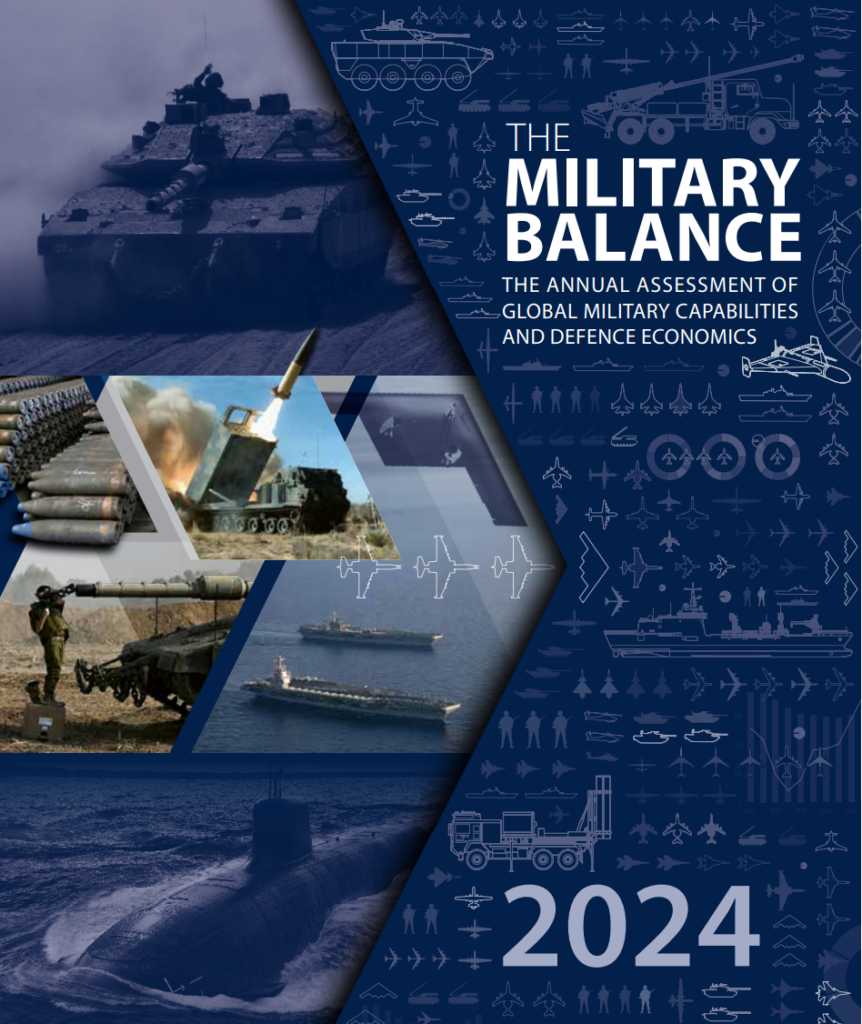
13 Feb. 2024
KEY FINDINGS:
•Russia has lost around as many tanks as it had in its active inventory when it launched the full-scale invasion of Ukraine in February 2022
•While Moscow has traded quality for quantity in its replenishment efforts, Ukraine, so far, has been able to offset equipment losses through Western donations, upgrading quality in the process
•Global defence spending grew by 9% to reach a record USD2.2 trillion, driven, in part by NATO member states boosting budgets in response to Russia’s aggression against Ukraine. Non-US NATO members now spend 32% more on defence since Russia’s 2014 invasion of Crimea
•Iran’s expanding influence on conflict areas manifested itself by the Houthis’ use of Iranian-supplied anti-ship missiles and Russia’s continued employment of Iranian-supplied UAVs
•China has demonstrated increased power-projection capacity, driving increased cooperation among Western and Asian militaries as a counterbalance
•Monitoring undersea critical national infrastructure is becoming a driver of maritime domain awareness efforts within national security establishments
The IISS Military Balance 2024 highlights the extent to which the world has entered a more dangerous period in the last twelve months, examining how increased tensions and conflict have reshaped the global defence-industrial landscape.
Our new data shows how countries are reshaping their equipment and spending plans and how their regional ties are changing in accordance with geopolitical reality.
The IISS Military Balance, now in its 65th year, shows the deteriorating security environment which is exemplified by a mounting number of conflicts, such as the Hamas–Israel war, Russia’s continued aggression against Ukraine, Azerbaijan’s takeover of the Nagorno-Karabakh region, coups in Niger and Gabon, as well as China’s more assertive manoeuvres around Taiwan, in the South China Sea and elsewhere.
In Ukraine, Russian equipment losses continue on a large scale. Our analysts assess that its full-scale invasion has cost Russia more than 3,000 main battle tanks, roughly as many as the Kremlin had in its active inventory before February 2022. Russia has been drawing on stored equipment to replenish losses.
Ukraine, meanwhile, has relied heavily on Western equipment to maintain its inventory levels and help underpin its deep battle to strike targets beyond the frontlines. But Kyiv also continued to demonstrate its ingenuity in other ways, using Western and indigenously developed systems to put Russia’s Black Sea Fleet on the back foot. It has also shown the utility of uninhabited maritime vehicles (UMV), giving the technology that other navies have been exploring a boost. The newest edition of The IISS Military Balance includes data on UMVs in country listings for the first time.
The combination of Russia’s war on Ukraine and rising tensions between with China and Western countries have been principal drivers of military spending. Global defence spending is up 9% from the previous year and poised to rise further in 2024, based on already announced spending commitments.
This era of insecurity is also resetting the global defence-industrial landscape. The US and Europe are ramping up production of missiles and ammunition and while progress has been slow, those efforts promise to soon deliver a greater defence production capacity after decades of underinvestment. Russia’s focus on equipping its armed forces is causing some long-term buyers of arms from Moscow to look elsewhere.
We reveal that non-US NATO countries now spend a combined 32% more than they did when Russia invaded Crimea in 2014, showing how Moscow’s actions have driven a response in the West. But that spending is only fixing long-standing issues and there are suggestions that inflation remains a concern, with costs for some types of ammunition more than doubling. The West’s basic inability to keep up with demand is being addressed, but gaps remain glaring.
While the West ramps up spending, so are China and Russia, which now dedicates more than 30% of government outlays to total military expenditure. The past year has also shown how some armed forces are reviving interest in equipment that had been neglected, such as artillery and air defence, while also embracing new technology, such as hypersonic glide vehicles and cruise missiles, or direct attack munitions. Nuclear weapons are also very much back on the agenda, with China adding missile silos and the United States modernising warheads and delivery systems.
A copy of the IISS Military Balance 2024 can be downloaded here. Please note that this link will expire at 00:00 GMT on Thursday February 26th.
Bastian Giegerich, Director-General and Chief Executive of the International Institute for Strategic Studies, said, “The IISS Military Balance is published at an important time when the rules-based order is being increasingly questioned. While Western defence spending is rising and plans to revamp equipment are ongoing, we reflect on the challenges including those set by Russia’s ongoing invasion of Ukraine, China’s military modernization and events in the Middle East. The IISS Military Balance remains an indispensable guide to defence capabilities and military data.”



